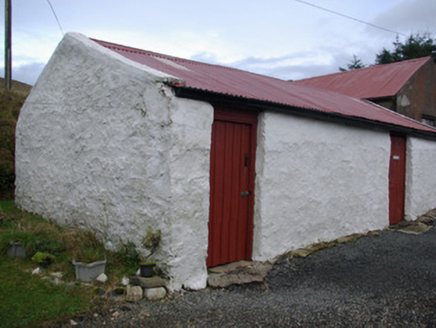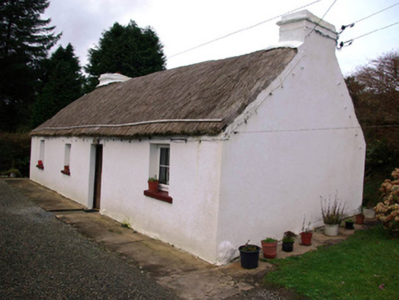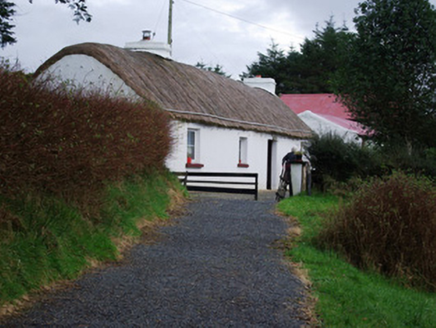Survey Data
Reg No
40908302
Rating
Regional
Categories of Special Interest
Architectural, Technical
Original Use
House
In Use As
House
Date
1800 - 1840
Coordinates
182302, 386023
Date Recorded
29/11/2007
Date Updated
--/--/--
Description
Detached four-bay single-storey vernacular house, built c. 1820. Still occupied. Pitched rope-and-peg thatched roof having two limewashed chimneystacks (on to the south-east gable end and one to the north-west side of centre) with stepped coping and with metal pegs below eaves (for securing ropes over thatch). Rendered walls. Square-headed window openings having painted sills and replacement windows. Square-headed door opening, located to the south-east side of centre, having timber sheeted door. Set back from small country road on an elevated sloping site in the rural countryside to the south-east of Ardara. Single-storey outbuilding to south-east of house having corrugated-metal roof, rendered rubble stone walls, and square-headed doorways with timber doors. Approach avenue to house from the south-west and forecourt to front of house.
Appraisal
Despite some alterations, this thatched vernacular house retains its early form and character and is an appealing feature in the rural landscape to the south-east of Ardara. Modest in scale, it exhibits the simple and functional form of vernacular building in Ireland. The loss of the original fittings to the windows fails to detract substantially from its visual appeal. Of particular interest in the survival of the thatched roof, which is now sadly becoming increasingly rare in Donegal. The rounded roof is a typical feature of thatched houses located close to the sea in exposed areas in the north-west of Ireland, while the pegs to the eaves were used to tie ropes (and sometimes nets) over the roof to secure it against the prevailing winds as is the case here at Meentanakill. The form of this building having chimneystacks to the south-east gable end suggests that this building is of the ‘direct entry’ type that is characteristic of the vernacular tradition in north-west Ireland. The location of the chimneystacks and the main doorway also suggests that this building was extended to the north-west by a bay at some stage. This house represents a fine surviving example of a once ubiquitous building type in the rural Irish countryside, and is a valuable addition to the vernacular heritage of County Donegal. The simple outbuilding adds to the setting and completes the context.





